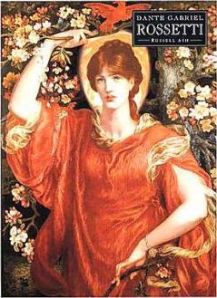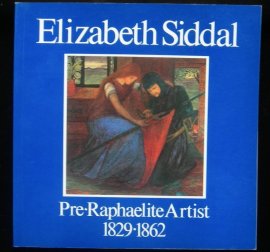 February
11
February
11
Elizabeth Siddal: The Pre-Raphaelite Supermodel
 On the 11th of February 1862, Elizabeth Siddal, an English artists’ model, died in London of a self-administered overdose of laudanum. In the early 1850s, as a young woman, Siddal was painted extensively by the Pre-Raphaelite Brotherhood. She sat for Walter Deverell’s Viola in Twelfth Night (1850), for William Holman Hunt’s British Girl in A Converted British Family Rescuing a Christian Priest from Persecution by the Druids (1851), for John Everett Millais’s Ophelia (1852) – for which she posed floating in a bathtub full of water, and for Dante Gabriel Rossetti’s Beatrice, the Virgin Mary, St Catherine, and many others. Rossetti became eventually her husband, and even though Siddal did pursue her own artistic career under the financial patronage of John Ruskin, it was Rossetti who became the eventual medium to Siddal’s posthumous legendary status. In fact, “[in] her lifetime, she had virtually no public identity, and in the twenty years following her death there were few published references made to her. Only when her husband died in 1882 did her ‘own’ history begin.” (Jan Marsh, Imagining Elizabeth Siddal, History Workshop, No. 25, Spring, 1988).
On the 11th of February 1862, Elizabeth Siddal, an English artists’ model, died in London of a self-administered overdose of laudanum. In the early 1850s, as a young woman, Siddal was painted extensively by the Pre-Raphaelite Brotherhood. She sat for Walter Deverell’s Viola in Twelfth Night (1850), for William Holman Hunt’s British Girl in A Converted British Family Rescuing a Christian Priest from Persecution by the Druids (1851), for John Everett Millais’s Ophelia (1852) – for which she posed floating in a bathtub full of water, and for Dante Gabriel Rossetti’s Beatrice, the Virgin Mary, St Catherine, and many others. Rossetti became eventually her husband, and even though Siddal did pursue her own artistic career under the financial patronage of John Ruskin, it was Rossetti who became the eventual medium to Siddal’s posthumous legendary status. In fact, “[in] her lifetime, she had virtually no public identity, and in the twenty years following her death there were few published references made to her. Only when her husband died in 1882 did her ‘own’ history begin.” (Jan Marsh, Imagining Elizabeth Siddal, History Workshop, No. 25, Spring, 1988).
Siddal, née Elizabeth Eleanor Siddall, was born on the 25th of July 1829 to a working-class family. Passionate about poetry, Siddal had a whimsical aura about her, which, especially in the age of Romanticism, made her distinguished look very attractive to men. Her brother-in-law described her as “a most beautiful creature with an air between dignity and sweetness with something that exceeded modest self-respect and partook of disdainful reserve; tall, finely-formed with a lofty neck and regular yet somewhat uncommon features, greenish-blue unsparkling eyes, large perfect eyelids, brilliant complexion and a lavish heavy wealth of coppery golden hair.”  (Russell Ash, Dante Gabriel Rossetti). In 1849, Siddal was spotted working in a milliner’s shop by Deverell, who then employed her to model for him. It was only a matter of time for Siddal to become the leading muse to the whole Pre-Raphaelite movement. However, each and every one of the painters used Siddal’s image in their own way, depriving her, as Griselda Pollock has claimed, of her own historical and artistic personality. (Griselda Pollock, Woman as Sign in Pre-Raphaelite Literature: A Study in the Representation of Elizabeth Siddal, Art History, Vol. 7, no. 2, June 1984). “[T]he persona of Elizabeth Siddal has been represented over the years, like a soft clay pot constantly shaped and reshaped and filled with new meanings.” (Jan Marsh, The Legend of Elizabeth Siddal).
(Russell Ash, Dante Gabriel Rossetti). In 1849, Siddal was spotted working in a milliner’s shop by Deverell, who then employed her to model for him. It was only a matter of time for Siddal to become the leading muse to the whole Pre-Raphaelite movement. However, each and every one of the painters used Siddal’s image in their own way, depriving her, as Griselda Pollock has claimed, of her own historical and artistic personality. (Griselda Pollock, Woman as Sign in Pre-Raphaelite Literature: A Study in the Representation of Elizabeth Siddal, Art History, Vol. 7, no. 2, June 1984). “[T]he persona of Elizabeth Siddal has been represented over the years, like a soft clay pot constantly shaped and reshaped and filled with new meanings.” (Jan Marsh, The Legend of Elizabeth Siddal).
In 1851, Siddal began sitting for Rossetti, who then developed some form of obsession for his model. The number of paintings he did of her oscillates around a few thousand. Rossetti and his muse got married in 1860, and Siddal, whose state of health had been fragile throughout her entire life, committed suicide in 1862. It was then that Rossetti’s obsession turned into insanity, as he became haunted by the ghost of love that had been often abused by him, when Siddal was still alive. Perversely, thanks to this obsession, Siddal’s image was being successively rehabilitated. The more time passed from her death, the stronger was her posthumous persona. For example, after Siddal’s death, overcome with grief, Rossetti enclosed in his wife’s coffin the only copy of his poems. “Some years later, in response to persuasion, he was said to have reluctantly agreed to an exhumation to retrieve the verses, subsequently published in 1870. This macabre event, which still provokes an emotional response, successfully helped to establish Rossetti’s position as a noteworthy Romantic artist alongside Keats, Byron and Shelley, and with it, the dependent reputation of his beautiful lover. Her role was also posthumously enhanced through the reproduction of her likeness in Rossetti’s painting of Beata Beatrix, as Dante’s beloved Beatrice at the moment of her rapture into heaven…” (Marsh).
 Whilst during Rossetti’s lifetime Siddal was still being perceived more as an icon of the Pre-Raphaelite movement, after the painter’s death, public attention started slowly turning towards her artistic personality. After a brief mention in Rossetti’s obituary, “[the] first full account of Elizabeth Siddal came from Hall Caine, whose Recollections of Rossetti (1882) disclosed that before marriage she had been her husband’s model and pupil, and described her as ‘a young lady of great personal beauty, in whom she discovered a natural genius for painting and a noticeable love of the higher poetic literature’. Also revealed was her drug addiction, when after marriage ‘the lady’s health began to fail’ and she resorted to laudanum to combat ‘neuralgia’; thereafter ‘her spirits drooped and her art was laid aside’.” (Marsh). It seems that the death of her lover and husband de-objectified Siddal and for the first time she became treated not as “a cipher for masculine creativity” (Pollock) but as an artist, and most of all – a woman.
Whilst during Rossetti’s lifetime Siddal was still being perceived more as an icon of the Pre-Raphaelite movement, after the painter’s death, public attention started slowly turning towards her artistic personality. After a brief mention in Rossetti’s obituary, “[the] first full account of Elizabeth Siddal came from Hall Caine, whose Recollections of Rossetti (1882) disclosed that before marriage she had been her husband’s model and pupil, and described her as ‘a young lady of great personal beauty, in whom she discovered a natural genius for painting and a noticeable love of the higher poetic literature’. Also revealed was her drug addiction, when after marriage ‘the lady’s health began to fail’ and she resorted to laudanum to combat ‘neuralgia’; thereafter ‘her spirits drooped and her art was laid aside’.” (Marsh). It seems that the death of her lover and husband de-objectified Siddal and for the first time she became treated not as “a cipher for masculine creativity” (Pollock) but as an artist, and most of all – a woman.










Thanks for an excellent post. Way back in college I had a print of Millais’s “Ophelia” on my wall for the longest time. Had not idea who the model was (actually I never even gave that a thought). Good to know something about her after all these years.
LikeLike
Thank you Erich! You are so right. There are quite a lot of incredible life stories behind many paintings. We will do our best to write about some of them on this blog.
LikeLike
This is so interesting – great post, thanks for sharing
LikeLike
Reblogged this on First Night History.
LikeLike
I am a big fan of the PRB’s rather treacly romanticism, but I have no illusions about it.
As for Liz, is this something new? Another woman who was just a pretty face and object of obsession for the men around her? And I don’t see that these artists “robbed” her of anything in particular. Nothing in your post indicates that she was a frustrated artist who couldn’t make her way in a man’s world – just an ‘artsy’ woman who was more or less taken for granted, as women (models) were. Is there some soon-to-be-published book revealing her great and hidden talent, heretofore unnoted?
Nice post though, juicy details :-).
Sometimes I think that fear and loathing of women is the motive force behind half of 19th century literature and painting!
Cheers!
LikeLike
I’ve always wondered who this woman in Millais’ famous painting was. Thank you for the information!
LikeLike
Excellent.
LikeLike
Thank you 🙂
LikeLiked by 1 person
I love much of pre-Raphaelite art and I have been lucky enough to see many of the famous [and not so famous] ones in the ‘flesh’ on my travels – Thank you for such a fascinating and well researched article…it’s truly wonderful to get a back-story to these famous images and the person!
LikeLiked by 1 person
Pingback: Elizabeth Siddal: The Pre-Raphaelite Supermodel | First Night History
Reblogged this on Lenora's Culture Center and Foray into History.
LikeLike
Wow, k in had no idea. What a sad and interesting back story
LikeLike